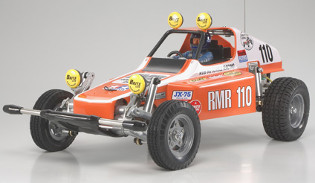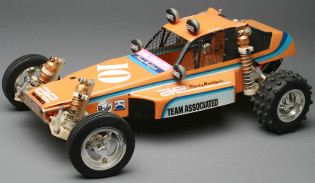The Vintage phenomenon
Vintage is an interest for something old that left its mark on its era. This has been extended to something that left its mark on someone at a given moment, even if the rest of the planet passed over it. To make it short, it is a kind of nostalgic cult, a meaning to own something one had sometime ago, or somehting that one did not owned at that time and he wants afterwards. In RC modeling, models prior to 1990 are concerned.
Tamiya is a major manufacturer in the RC model hobby and several of their models are considered as outstanding. This is especially the case for the 50 first models ("metal" era), but also for the next 50,even if some purists have a different point of view (the 51st marks the transition to the "all plastic" production).
Whatever the number of concerned models, the vintage phenomenom can be explained with the following reasons:
- Tamiya is one of the forerunners in RC modeling for masses
- Tamiya has been an major actor on the market for almost 40 years without interruption
- Tamiya brought real innovations on several of their models
- like in all domains, there are collectors
The appeal for Vintage caught the eye of the manufacturers: soon, Tamiya detected their fan interest. As soon as year 2000, they re-released one of their very first models, the famous XR311. Today, the re-release program is verry active: either be almost identical to original re-releases of sometimes several decades-old models or be modernized versions (an original bodyshell fitted to a modern chassis), Tamiya can revisit almost their entire catalog. This strategy is much appreciated by fans who now can get models they couldn't offer in the 80's. It is also appreciated by collectors restoring old models since rare parts suddenly become available (and at decent price). On the opposite, some collectors really got upset because the re-release program ruined their efforts to restore true original models, not counting the financial loss due to the burst of the speculative bubble on old models.
Other "historical" manufacturers joined this juicy re-release market, at least those that are still active on the market. Associated launched their re-release program with their famous RC10 Gold, the buggy that revolutionized RC racing in the middle of the 80's. Kyosho joined too in 2014 re-releasing their Scorpion, another iconic buggy from the early 80's.
Tamiya Rough Rider (1979)

Kyosho Scorpion (1982)

Associated RC10 (1984)

Successively, each one of these buggies greatly influenced the overall RC world. One after the other, they were true kings of the tracks for 2 to 3 years, each knowing an unchallenged dominance period until the next one made it obsolete. Trully, each of these models represent a great leap forward in terms of performances and handling: these are 3 outstanding iconic models in electric RC history.
Many information can be found on internet, both on fan sites and forums. I recommend you visit these very interesting sites:
- Vintage-RC a reference for vintage and modern Tamiya models(in french)
- Tamiya 101 presents awsome photos and videos of Tamiya's 100 first models (in english)
- TamiyaClub for their members photo galleries and the forum (in english)
- TamiyaBase which is a gold mine as a whole (in english)
- Tamiyablog which is THE one site about Tamiya news (in english)
Tamiya kit references
Tamiya kits references evolved over more than 30 years of activity.
The first numbering system was used with the first 30 models. The reference was made of a series of letters and digits: RA-1201 (Porsche 934 Turbo RSR), RA-1015 (Rough Rider) upto RA-1030 (Honda Formula 02 (CS)). "RA" refers to the production line (RC models), the first pair of digits (10, 12) to the kit scale (1/10th or 1/12th), and the last pair of digits is the kit number.
The second numbering system made it simpler by removing the scale reference and by changing the production line letters by code 58. So kit references became 5831 (Brabham BT-50 BMW Turbo), upto 5865 (Clod Buster). Then Tamiya realized the series would end with kit number 99.
That is why an additional "0" digit was introduced after the "58" production line code. The Super Sabre (kit 58066) started this new numbering system, and it is still active. That leaves room for a thousand of models.
By extension and to make it easier, old models references where modified afterward to comply with the new numbering system.
The kits can receive a 49xxx reference if they are produced in limited edition. This includes some re-releases (49154 Tyrell P34 Six Wheeler), Chrome Metallic editions (49337 Wild Willy 2), Gold editions (49459 Lunch Box) or racing chassis that yield world championship titles to Tamiya (49394 TRF415MSX Marc Rheinard). This reference type is also used for limited series of spare parts (specific color or material).
Finally, factory assembled and painted models receive a 57xxx reference type. Normally, they are identical to their counterpart kit, but they may feature different dampers (friction instead of hydraulic) or speed controller (mechanical instead of electronic). On the other hand, the body is already painted and decorated and the model is provided with a complete radio set, stick pack and charger (upon local distributor choice). In my collection, the Madbull, the Xsara WRC and the Sand Viper are XB Expert Build models.




